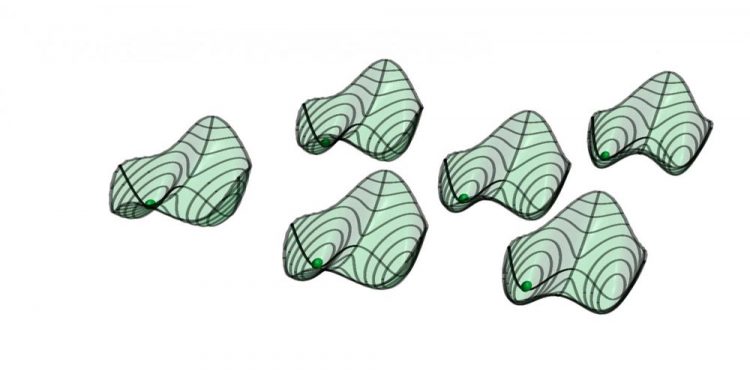Appreciating the classical elegance of time crystals

Quasi potentials of six parametric oscillators with weak all-to-all coupling. Stable solutions are located at the minima. The balls indicate the symmetric solution, where all oscillators are in phase. (Screenshot from accompanying animation) Credit: ETH Zurich/D-PHYS Toni Heugel
In a crystal, atoms are highly ordered, occupying well-defined locations that form spatial patterns. Seven years ago, the 2004 Physics Nobel laureate Frank Wilczek pondered the possibility of a 'time analogue of crystalline spatial order' – systems that display sustained periodic temporal modulations in their lowest-energy state.
The concept of such structures with an oscillating ground state is highly intriguing. Alas, not long after the idea has been published, it was proven that such time crystals are not possible without breaking fundamental laws of physics.
Not all was lost, though. Subsequent theory work suggested that when quantum many-body systems are periodically driven, then new persistent time correlations emerge that are evocative of Wilczek's time crystals.
These driven systems were dubbed 'discrete time crystals', and in 2017 the first experimental realizations of such states were reported in ensembles of coupled particles (ions, electrons and nuclei) that display quantum-mechanical properties.
A not-so-brief history of time crystals
Before long, astute observers spotted distinct similarities between discrete time crystals in quantum systems and so-called parametric resonators, a concept in classical physics reaching back to work by Michael Faraday in 1831. The connection between these two bodies of work remained, however, opaque.
Now, a new framework goes a long way towards lifting the ambiguities surrounding the similarities between periodically driven classical and quantum systems.
Writing in an article published today in the journal Physical Review Letters, Toni Heugel, a PhD student in the Department of Physics at ETH Zurich, and Matthias Oscity, a Master student there, working with Dr. Ramasubramanian Chitra and Prof. Oded Zilberberg form the Institute for Theoretical Physics and with Dr. Alexander Eichler from the Laboratory for Solid State Physics, report theoretical and experimental work that establishes how discrete time crystals can be generated that, on the one hand, require no quantum mechanical effects and, on the other hand, display genuine many-body effects, which is a characteristic of discrete time crystals reported in quantum systems.
Many ways to subharmonic frequencies
There is one obvious similarity between classical parametric resonators and experimentally realized discrete time crystals in quantum many-body systems: Both display emergent dynamics at frequencies that are fractions of the drive frequency. In the context of discrete time crystals, the emergence of oscillations at such subharmonic frequencies breaks the temporal periodicity of the driven system, providing a form of 'time analogue' to crystalline spatial order, where the symmetry of space is broken.
In classical parametrically driven systems, subharmonic frequencies appear in more familiar ways: A child on a swing, for instance, modifies the centre of gravity at twice the frequency of the resulting oscillation; or the ponytail of a runner oscillates at half the frequency of the vertical head movement.
But do these dissimilar phenomena have anything to do with one another? Yes, say the ETH physicists. In particular, they pinpoint where many-body aspects appear in classical systems. To do so, they considered classical nonlinear oscillators with tunable coupling between them.
Unifying framework for periodically driven classical and quantum systems
It is well known that for certain driving frequencies and strengths, parametric oscillators become unstable and then undergo a so-called period-doubling bifurcation, beyond which they oscillate at half their driving frequency. Heugel, Oscity and their colleagues explore what happens as several such oscillators are coupled together. In calculations as well as in experiments — using two strings with variable coupling between them — they find two distinct regimes.
When the coupling is strong, the two-string system moves collectively, recreating in essence the movements of the child on a swing or the ponytail of a runner. However, in the case of weak coupling between the strings, the dynamics of each string is close to that displayed by the uncoupled system. As a consequence, the coupled oscillators do not bifurcate collectively but bifurcate individually at slightly different parameters of the drive, leading to richer overall dynamics, which gets ever more complex as the systems get larger.
The ETH researchers argue that such weakly-coupled modes are similar to the ones that emerge in quantum many-body systems, implying that their framework might explain the behaviours seen experimentally in these systems. Moreover, the new work prescribes general conditions for generating classical many-body time crystals. These could ultimately be used to both interpret and explore features of their quantum counterparts.
Taken together, these findings therefore provide a powerful unifying framework for periodically driven classical and quantum systems displaying dynamics at emergent subharmonic frequencies — systems that have been so far described in very different contexts, but might be not that dissimilar after all.
Media Contact
All latest news from the category: Physics and Astronomy
This area deals with the fundamental laws and building blocks of nature and how they interact, the properties and the behavior of matter, and research into space and time and their structures.
innovations-report provides in-depth reports and articles on subjects such as astrophysics, laser technologies, nuclear, quantum, particle and solid-state physics, nanotechnologies, planetary research and findings (Mars, Venus) and developments related to the Hubble Telescope.
Newest articles

First-of-its-kind study uses remote sensing to monitor plastic debris in rivers and lakes
Remote sensing creates a cost-effective solution to monitoring plastic pollution. A first-of-its-kind study from researchers at the University of Minnesota Twin Cities shows how remote sensing can help monitor and…

Laser-based artificial neuron mimics nerve cell functions at lightning speed
With a processing speed a billion times faster than nature, chip-based laser neuron could help advance AI tasks such as pattern recognition and sequence prediction. Researchers have developed a laser-based…

Optimising the processing of plastic waste
Just one look in the yellow bin reveals a colourful jumble of different types of plastic. However, the purer and more uniform plastic waste is, the easier it is to…


